Art Fairs
At London’s 1–54 Fair, Curator Azu Nwagbogu Lays Out the Pitfalls of the New Wave of Interest in African Contemporary Art
The former Zeitz Mocaa curator and founder of LagosPhoto offers his advice on unlearning old ways of seeing.
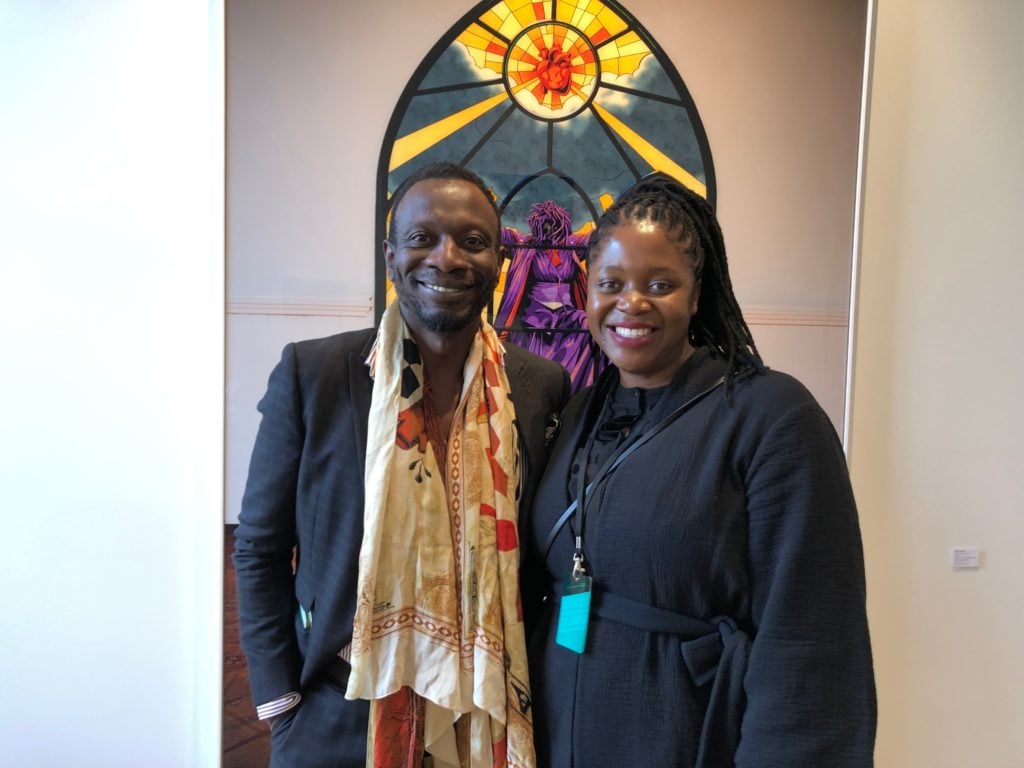
The former Zeitz Mocaa curator and founder of LagosPhoto offers his advice on unlearning old ways of seeing.

by
Kate Brown

In the courtyard of London’s neoclassical Somerset House, artist Kiluanji Kia Henda and curator Azu Nwagbogu are standing together ruminating on Henda’s large black iron sculpture. The work casts a thin shadow along the cobblestoned courtyard of the muscular Royal palace. “It looks better in the Angolan desert,” Henda points out. Nwagbogu nods his head in careful agreement.
The whole point of this ghostly piece of architecture by Henda, called The Fortress, is to draw attention to how ephemeral the human constructions that it silhouettes really are. The artist, though represented by Goodman Gallery, which is a regular at Frieze London, is nevertheless happy about the work’s central presence at the 1–54 Contemporary African Art Fair.
The event is rapidly emerging as a star contender in London’s bustling art fair calendar, setting itself apart from the rest by dedicating itself to presentations of African art. The fair’s presence this year within Somerset House’s old imperial building reads as a deliberate disruption of the aesthetics of English-ness.
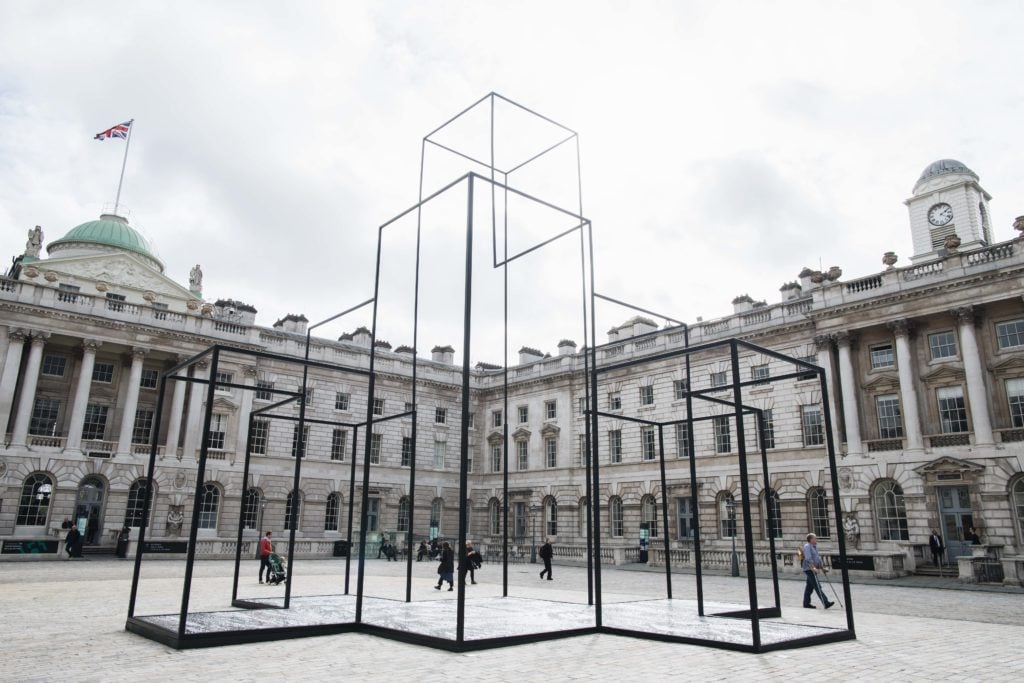
The Fortress by Kiluanji Kia Henda on view in the courtyard of Somerset House during 1.54 African art fair. © Katrina Sorrentino
Nigerian curator Azubuike Nwagbogu and Henda seem to have known each other for a while—but then again Nwagbogu, who has agreed to share his expertise with me at this fair, seems to know every second or third person here. As we find a spot for a quiet coffee before plunging into the display of 46 international galleries presenting here, I start by confessing my lack of real knowledge of African art.
“Well, you saying that means that you are, in fact, starting at the right place,” says Nwagbogu. “You cannot be outside of the African art scene and pretend to be an expert.” The curator is himself undeniably a razor sharp authority on the continent, an active member of the art scene for most of professional his life in multiple countries.
Until a month ago, he was acting chief curator of one of Africa’s top museums, the Zeitz Mocaa in Capetown (he passed the reigns to curator Koyo Kouoh). Now once more an independent curator, Nwagbogu is busy. He has a Lagos-based nonprofit, the African Artists’ Foundation (AAF), which supports emerging talent on the continent, and he is planning LagosPhoto, the annual photo festival which he founded and which opens on October 27.
Nwagbogu’s enthusiasm for African artists visibly bubbles over. Nevertheless, he expresses caution regarding the grouping of an entire continent’s artistic production together—a point that notably seems to call into question the very premise of the 1-54 fair.
“I’m interested in other angles,” he admits. “I want to limit the blind spots, and I want to normalize the existence and the representation of African art, which you cannot do if you continue to isolate it. African art continues to attenuate itself because we still own this narrative of othering ourselves. I am interested in image-makers who load their work with poetry and feeling—that is what I want to find today.”
With that aim in mind, we put down our coffee cups and head in.
The first stop is Accra-based Gallery 1957, where one of Nwagbogu’s favorite artists, the Côte d’Ivoire photographer Joana Choumali, is presenting works. By the time we get to the space, which is chock-a-block with collectors, more than half of her small works, which are embroidered photomontages that range between £5,000 and £7,000, are either sold or on reserve. Choumali is currently shortlisted for the eighth edition of France’s Prix Pictet prize for international photography.
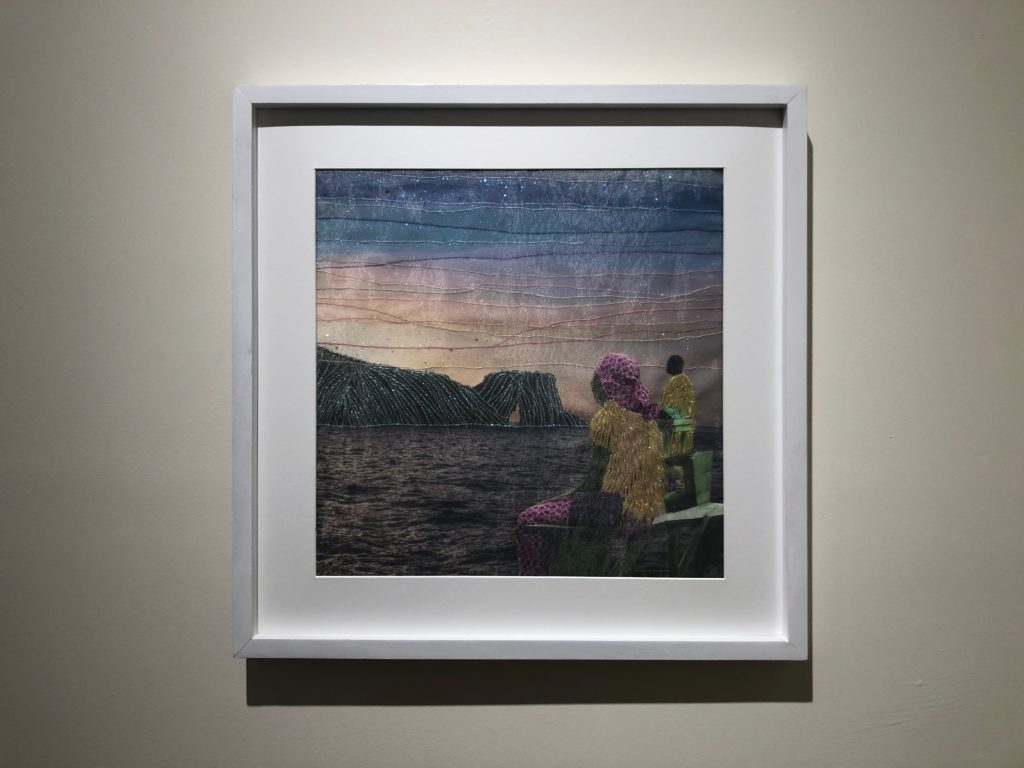
Joana Choumali’s work at Gallery 1957 at 1-54 African art fair, a photomontage that is embroidered and overlaid with six pieces of translucent gauze. It was sold by 11 a.m. on preview day. Photo: Kate Brown
“I’m really excited about artists who are interested in image-making, like Joana,” says Nwagbogu. “It’s more than time to move past this dated idea of post-photography. Where we are today is so much for advanced.”
On another wall at Gallery 1957, British-Ghanaian artist Godfried Donkor, who has never been exhibited before in the UK, presents tall works on blown-up pages from the Financial Times stock page listings, on which he has overlaid figures in oil and ink. Again, these works oscillate somewhere between the painterly and the photographic. Both sold for around £8,000 to a private US collection.
As we continue to explore fair, Nwagbogu takes note of where the various exhibitors are based. “When I come to 1-54 art fair,” he explains, “my interest is really in galleries that have roots in Africa—galleries that are invested in the ecosystem of the local African art scene beyond the commercial and event economies.”
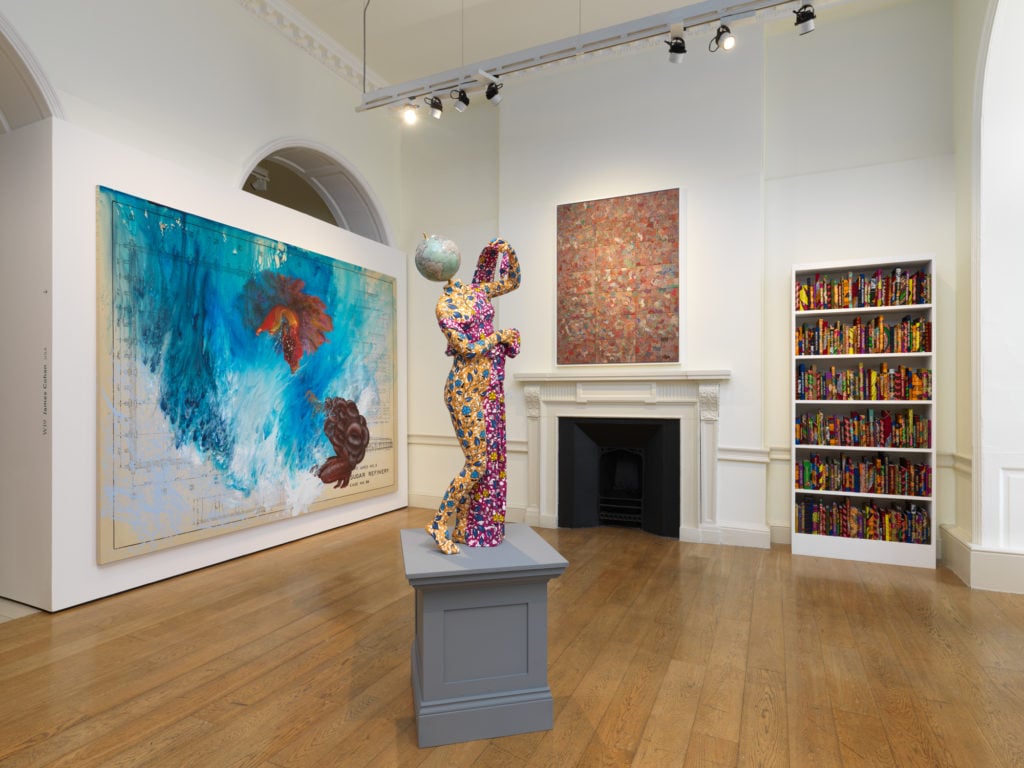
View of James Cohan gallery’s presentation at 1-54 art fair. Photo: James Cohan Gallery.
At this year’s edition, over half of the galleries are from the global north (Europe, the UK, and the US), including spaces like New York’s James Cohan, which had an impressive display that paired two sculptures by Yinka Shonibare CBE with several wall works by Ethiopian artist Elias Sime. (Jane Cohan told artnet News that the “exceptional” quality of discussions with curators and collectors is a major drawing point, not to mention the intimate scale of the Somerset House, which “leads to deeper connections in the artwork.”)
Just 18 galleries, or 38 percent, have bases in Africa. Six of these are South Africa-based dealers, with the rest amounting to a thin peppering of spaces from other nations including Egypt, Morocco, and Nigeria.
Nwagbogu points out that his concern over whether African art is represented by insiders or outsiders is not necessarily reducible to questions of race or national origin.
He brings up Viviane Sassen. The Dutch photographer spent her childhood in Kenya and has made renowned portraits of black subjects. “Being African is not about your race or color,” Nwagbogu says. “It is about your sensibility, your influences.”
In general though, Nwagbogu hopes that the scene will continue to move beyond what he describes as limiting “tropes” in contemporary African art. In particular, he notes the “explosion” of work focusing on the beautiful black body at art fairs.
“The history of art eliminated the black body and it almost feels like now there is a deliberate effort by black artists to say, ‘we exist, we are beautiful, we are here,'” he says. “But now you see a lot of it—maybe too much of it. By reclaiming the black body, which has been objectified for the longest time and excluded, you become that cliché. I am more interested in what happens beyond that.”
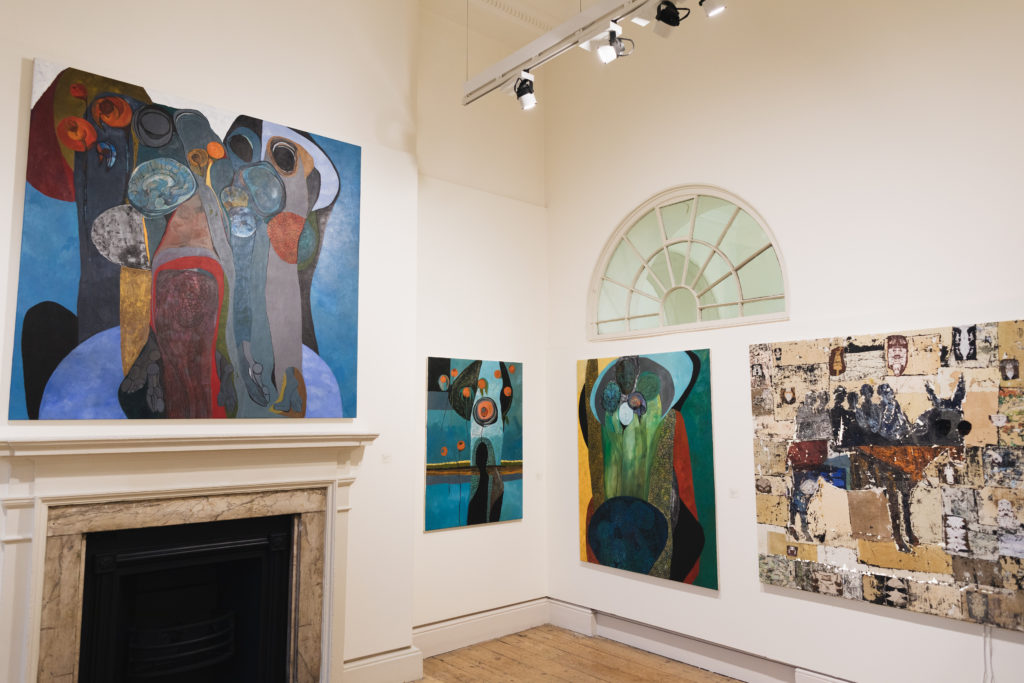
View of Addis Fine Art’s presentation of Merikokeb Berhanu. © KatrinaSorrentino.
We stop in at Addis Fine Art. There, Nwagbogu expresses his excitement as he discovers Ethiopian painter Merikokeb Berhanu, whom he says fits into this idea of moving “beyond.” He points to her poetic balance between figuration and abstraction, and how natural and anatomical elements seem to flow into one another. For such stunning works, the prices seem more than fair, lingering just under €10,000.

Oubliez le passé et vous perdez les deux yeux by Eddy Kamuanga Ilunga on view at October Gallery.
At October gallery, Nwagbogu highlights the promising young Congolese painter Eddy Kamuanga Ilunga, whom he says is a prime example of the Kinshasa painting scene’s penchant for hyperrealism.
But he has a criticism, or at least a concern. “Again though, we are seeing blackness represented as an object,” he says as we cast our eyes over Ilunga’s subjects, which have cellphone chip patterns painted on their skin.
One example of an artist Nwabogu thinks usefully complicates some of the “tropes” is Johannesburg artist Mary Sibande. The fast-rising star in conceptual photography and sculpture has an incredible work on view at South Africa’s SMAC Gallery, part performance, part sculptural installation, part photo.
The image eludes easy reading—which is exactly what Nwagbogu finds important about it.
It shows Sibande crouched below a window wearing a traditional dress of a domestic worker, a persona she continually represents in her artwork, called “Sophie.” Her face is obscured by alien-like fabric tentacles. Behind her, she is again depicted in a stained glassed window. (Called Turn, turn, turn, turn (2019), the work sold for between £8,000 and £12,000 by the end of preview day on Wednesday.)
“Everyone knew a Sophie,” a representative from SMAC explains. “Sophie is an avatar that embodies the mothers and grandmothers who were domestic workers for white families during Apartheid.” However, when the artist started to find that Sophie’s popularity in the art world signified that she was becoming “an appeaser of guilt,” the artist changed course. She tried to complicate the narrative.
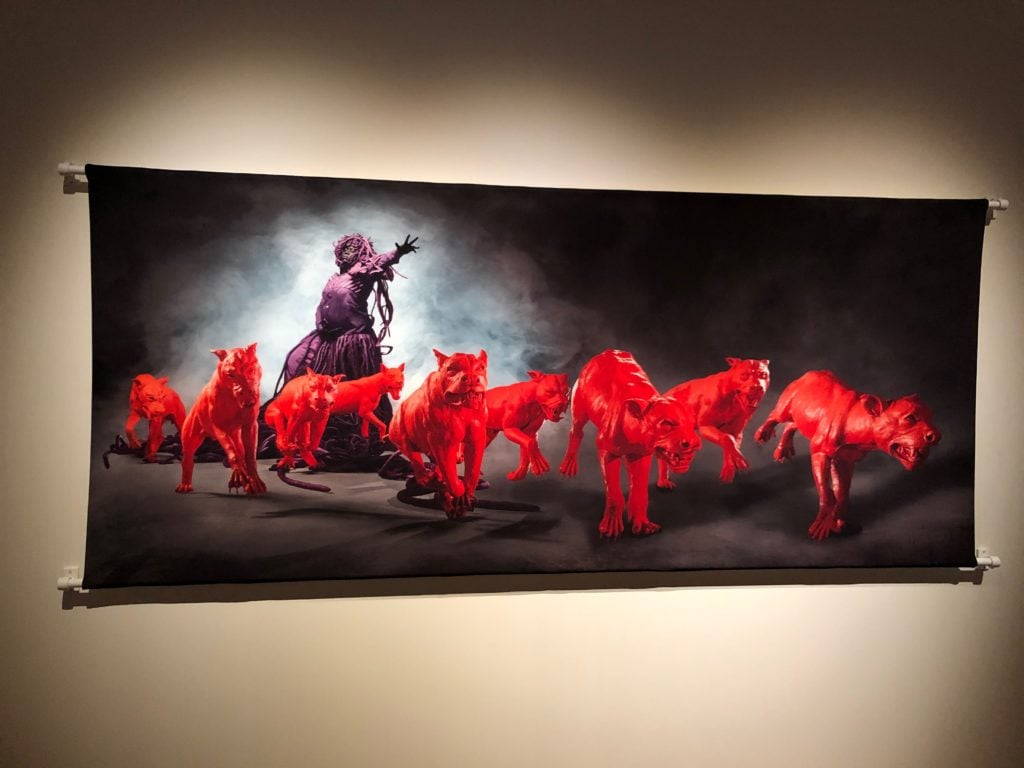
A work on view from Mary Sibande’s solo exhibition “I Came Apart at the Seams” currently on view at Somerset House. Photo: Kate Brown
Just around the corner from their SMAC’s presentation at Somerset House is a multi-room exhibition by Sibande, presented in partnership with the fair as part of the venue’s Charles Russell Speechlys Terrace Rooms Series (it is on view until January 5, 2020).
Titled “I Came Apart at the Seams,” the exhibition is filled with new, progressive versions of Sophie. The largest work, on loan from the MAC/VAL museum outside of Paris, is a sculpture of Sophie that is scaled to Sibande’s body. Sophie seems to be dancing as masses of purple tentacles emanate out of her and creep up the wall. It is a must-see.
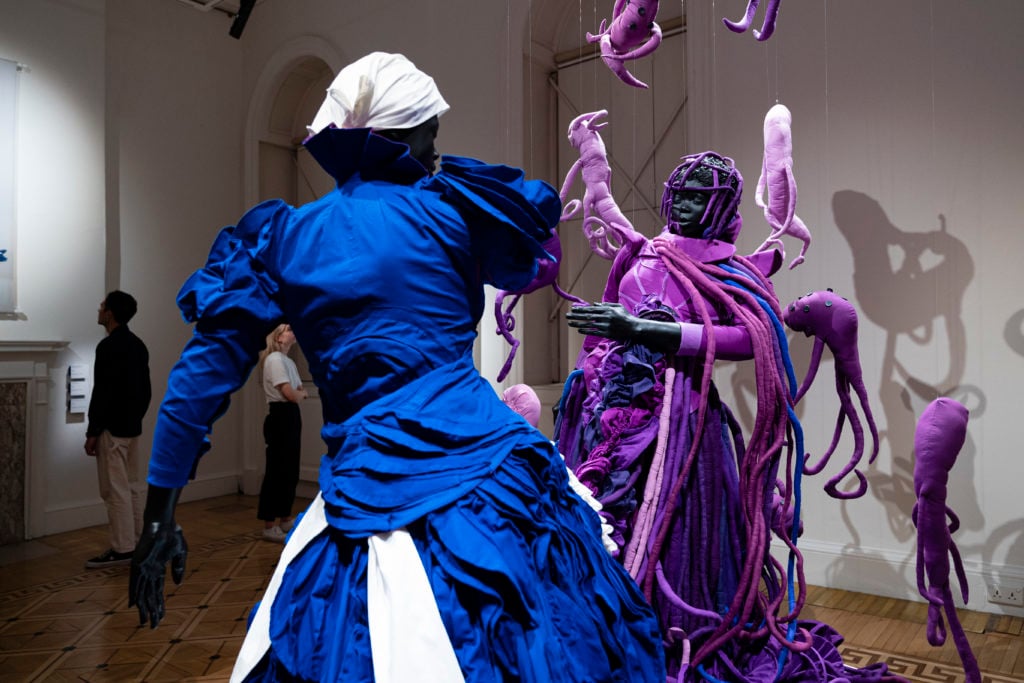
A Reversed Retrogress, Scene 1, 2013 by Mary Sibande © Anne Tetzlaff, Mary Sibande.
“Mary has developed a fascinating way of embracing material culture to create empowered identity that is not about the presentation of an image but about the creation of a voice,” says Nwagbogu. “OK, so we are here, we exist, we know that now—but what are we doing with that agency, what are we saying with our presence? This is the question we should be concerning ourselves with.”